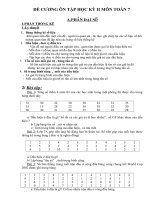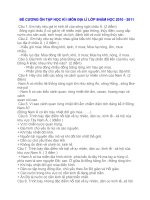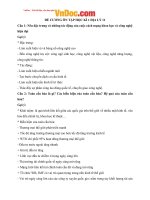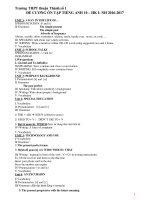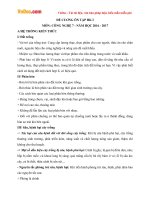Đề cương ôn tập học kì 2 môn Tiếng Anh lớp 11 năm 2019 - 2020 chi tiết - Phần 2 | Tiếng Anh, Lớp 11 - Ôn Luyện
Bạn đang xem bản rút gọn của tài liệu. Xem và tải ngay bản đầy đủ của tài liệu tại đây (286.15 KB, 11 trang )
<span class='text_page_counter'>(1)</span><div class='page_container' data-page=1>
<b>ĐỀ CƯƠNG ÔN TẬP HK2 _ ENGLISH 11</b>
A.Lý thuyết:
I. Nội dung ôn tập: Unit 6,7,8,9,10
II. Ngữ pháp:
- Perfect participles & perfect gerund
- the present perfect or present perfect continuous tense
- the relative clauses with participle or to-infinitive clauses
- -Ing or -ed participles
- conditional sentences (Type 0, Type 1, Type 2)
B. Bài tập
<b>UNIT 6: Global warming</b>
<b>Exercise 1. Match the words/ phrases with their definitions</b>
1.greenhouse gas
2.climate change
3.emission
4.carbon footprint
5.global warming
6.infectious disease
7.ecological balance
8.heat-related illness
a. an increase in the average temperature of the earth’s atmosphere
b. the amount of carbon dioxide released into the atmosphere
c. a gas in the atmosphere that traps heat above the earth
d. a gas or other substance which is sent out into the air
e. an illness that can be passed from one person to another, especially through the air
people breathe
f. poor health resulting from extreme heat
g. a long-term change in the earth’s weather due to changes in the atmosphere
h. a stable ecosystem in which a large number of species live together
<b>Exercise 2: Fill in each sentence with the words from the box. </b>
infectious diseases carbon footprint greenhouse gases emissions
ecological balance heat-related illnesses climate change
1.Having measured the company’s ……….., they realised that the amount of carbon dioxide (CO2) it produced
was great.
2.Scientists have warned about the relationship between climate change and the spread of ……….
3.A large amount of carbon dioxide ……… are released into the atmosphere by burning fossil fuels.
4.Deforestation is one of the biggest environmental threats to the ……… in the world.
5.As global temperatures rise, there are more cases of ………..
6.Although global warming is causing changes in weather patterns, it is only one aspect of ………..
7. Global warming occurs when the ……….. in the atmosphere trap the heat from the sun.
<b>Exercise 3: Fill in each sentence with the words/ phrases from the box. </b>
carbon footprint deforestation energy use extinction
emissions absorb catastrophic diversity
1.I believe that the only way for us to reduce global warming is to cut down on ……….
2.Many species are threatened with ……….. due to deforestation and loss of habitat.
3.Motor vehicles running on petrol are responsible for a large amount of carbon dioxide ……….
4.There are many ways for us to reduce our ………. in order to save our environment.
5.More trees should be planted as they ……… carbon dioxide and give off oxygen.
6.The alarming rate of ………. results in damage to the quality of the land.
7.Rainforests have the highest species ……… on the earth.
8.Global warming has proved truly ……….. for the environment.
<b>Exercise 4: Read the text and do the tasks follow </b>
</div>
<span class='text_page_counter'>(2)</span><div class='page_container' data-page=2>
people in the Young Voices for the Planet show that even at a young age, people are able to do something for
their communities and can really contribute to the care and preservation of the environment. Kids can also do
things to make a difference, given the chance. And though their skills and talents may vary, they can use their
unique gifts to help to preserve the environment and save the world. One of the children in the stories, Olivia,
says:
‘Every one of us has a great gift we can use to help the earth. Everyone, at any age, can do something, whether it
is picking up rubbish along the side of the road, filling a bird feeder, or bringing reusable bags to the grocery store.
For me, I used my artwork. Find your cause and use your talents. The quality of our world is counting on you.’
It is remarkable that someone as young as Olivia can understand so well the connection between society, the
environment, and the problems we are facing today. It has been proved that every small act of kindness we show
can make a great impact on the world around us.
For some people, environmental protection and conservation means stopping the growth and development of
technology and society. But this is a popular belief that is not true. Protecting the environment isn’t about
stopping progress. It’s about changing our consumption habits and taking care of the environment. Just by doing
simple things, every one of us including the youths can do their share in making this world a better place to live.
<b>a. Answer the questions</b>
1.What do most people believe?
………
2.What do the stories of the young people in the Young Voices for the Planet show?
………
3.According to Olivia, what are the things that people can do to help the earth?
………
4.What talent did Olivia use to help the environment?
………
5.What does the writer find extraordinary and unusual about Olivia?
………
<b>b. Decide whether the sentences are true (T), false (F) or not given (NG)</b>
1.According to Olivia, only young people can use their talents to help the earth.
2.If you don’t have talents, you can’t help to preserve the environment and save our world.
3.Even a small act of kindness can make a great impact on the world around us.
4.If we want to preserve the environment, we should stop the growth and development of technology and
society.
5.The future of our world depends on young people only.
6.People should change their consumption habits to preserve the environment.
<b>Exercise 5:Rewrite sentences using perfect participles</b>
1.After I watched the documentary about wildlife, I made a donation to an environmental society.
………
2.After I ate my evening meal, I decided to go for a walk
………
</div>
<span class='text_page_counter'>(3)</span><div class='page_container' data-page=3>
4.Since the authorities had managed water resources irresponsibly, they had to deal with water shortages in the
region.
………
5.After we had read the stories about people who reduced their carbon footprint, we started to change our daily
consumption habits.
………
6.Because the farmers had been told about the dangers of chemical fertilisers, they turned to bio-fertilisers.
………
7.After I finished all my homework, I watched my favourite film on TV.
………
8. After we made all necessary preparations, we put our plan into action.
………
<b>Exercise 6: Combine sentences using perfect gerunds</b>
1.He risked his own life to rescue the little boy. He was really admired for that.
………
2.She raised $20,000 for wildlife protection. She was praised for that.
………
3.I have advised you on how to cut down your energy use. I remember that.
………
4.Some scientists have not reported the effects of climate change. They are accused of that.
………
5.They have acted irresponsibly towards the environment. They were criticised for that.
………
6.The factory has dumped a huge amount of rubbish into the river. It was fined for that.
………
7.He didn’t keep his promise. He apologised for that.
………
8. He said that he would take responsibility for the project. But then he denied that.
………
<b>UNIT 7: FURTHER EDUCATION</b>
<b>Exercise 1: Fill in each sentence with the words from the box. </b>
Academic analytical vocational major postgraduate
1……….. courses should teach practical skills in addition to critical thinking.
2.When a student enters a college or university, he / she has to choose a main subject of study, which is
called ……….
3.Specialised ……… courses such as design and cooking are very popular.
4.Students with bachelor’s degrees can pursue ……….. education to get master’s or doctoral degrees.
5.Higher education students need to have ……….. skills so that they can analyse a problem scientifically.
<b>Exercise 2: Match the words with their meanings</b>
1.pursue (v)
2.appreciate (v)
3.respectively (adv)
A. equired by rules and regulations
B. increase knowledge or experience
</div>
<span class='text_page_counter'>(4)</span><div class='page_container' data-page=4>
4.mandatory (adj)
5.broaden (v)
D. follow something and try to achieve it
E. in the order mentioned
<b>Exercise 3. Complete these sentences using the correct form of the words in brackets</b>
1.Although Kevin did not have any ………. qualifications, he had a lot of practical experience. (academy)
2.Having two majors can ………. your employment potential. (broad)
3.Maria wants to take a gap year after her secondary school ……….. (graduate)
4.Most universities are now offering courses to help students to improve their …………. skills. (analyse)
5.How long is your medical ……….. in this hospital? (intern)
6.A bachelor’s degree and a master’s degree in the UK usually require three and one year of study, ………..
(respective)
<b>Exercise 4. Complete these sentences with the verbs in the box. Use the present perfect or the present perfect </b>
<b>continuous</b>
travel wait attend take write
1.Since January, we ……….. part in three discussions on higher education.
2.I’m sorry I’m so late! How long / you ……….. for me?
3.How many academic courses / you ……….?
4.I ………. my research paper since October and I am trying my best to finish and submit it to my
professor next week.
5.Alice ……… in Viet Nam during her gap year and will return to the United States in December.
<b>Exercise 5: Choose the correct answer</b>
<b>1.I (have read/have been reading) three books on vocational training to complete this project.</b>
<b>2.I (have read/have been reading) a report on further education since last Monday. I will finish it this Sunday.</b>
<b>3.(Have you applied/Have you been applying) for the scholarship to study in Singapore?</b>
<b>4.I (have waited/have been waiting) for the university’s reply about entry requirements for a whole week. I hope </b>
to receive it soon.
<b>5.Prof. Wilson (has given/has been giving) the same seminar to students for the last 12 years.</b>
<b>6.I (have never understood/have never been understanding) why so many young people want to study abroad.</b>
<b>Exercise 6: Read the text and choose the best heading and then decide whether the sentences are true (T), false</b>
<b>(F) or not given (NG)</b>
<i><b>A. Comparing the A-level and IB Diploma Programme</b></i>
<i><b>B. Preparing for higher education in the United Kingdom</b></i>
<i><b>C. IELTS and further education in the United Kingdom</b></i>
In the United Kingdom (UK), there are many opportunities for students who wish to continue their education after
finishing secondary school. Not only British students, but also students from all over the world have been
pursuing UK’s higher education qualifications – bachelor’s degrees, master’s degrees and doctorates – as they are
usually highly appreciated worldwide. In order to prepare for higher education at a university or college, students
need to consider academic qualifications such as the A-level or International Baccalaureate (IB) Diploma
Programme.
</div>
<span class='text_page_counter'>(5)</span><div class='page_container' data-page=5>
An alternative to the A-level is the IB Diploma Programme, which provides qualifications in six or seven subjects,
among which mathematics, native language and theory of knowledge (TOK) are mandatory. TOK is a two-year
subject which aims to broaden students’ understanding of the interactions among different school subjects. This
programme is now available in more than 200 state and independent schools and colleges in the UK.
Students whose first language is not English need to take an English language test like IELTS (International English
Language Testing System) before applying to any higher education courses. As there are two versions of the IELTS
– Academic and General Training – students should ask the institution they are applying to which version is
required.
1.In the UK, there are many opportunities for students to pursue vocational education.
2.Only British students are allowed to pursue higher education in the UK.
3.Mathematics and chemistry are compulsory subjects for the A-level qualification.
4.After finishing their A-levels, students have to take part in the IB Diploma Programme.
5.Students whose mother tongue is not English have to take an English language test.
<b>Exercise 7: Rewrite the sentences, using the present perfect or the present perfect continuous</b>
1.The graduate students started arriving at four o’clock. They are still arriving.
………..
2.The graduate students started arriving at four o’clock. They are all in the lecture hall.
………..
3.She started her research project last month. She’s still doing it.
………..
4.They visited this college in 2009, 2012 and 2014. (three times)
………..
5.I started learning how to play the piano eight months ago. I’m still learning it.
………..
6.I started discussing my research proposal with my professor at the beginning of my course. We’re still discussing
it.
………..
<b>Exercise 8:Rewrite the sentences, using the present perfect or the present perfect continuous</b>
1.Nam’s still studying English. He started studying it two years ago. (for)
……….
2.He attended two online vocational courses: one in 2012 and the other in 2013. (twice)
……….
3.The British Council established IELTS a long time ago. It still uses this test as an international standardised test of
English for non-native English language speakers. (for)
……….
4.The university started building a new campus in May. They are still building it. (since)
……….
5.Mary is staying at a homestay during her undergraduate programme. The programme began three weeks ago.
(for)
……….
</div>
<span class='text_page_counter'>(6)</span><div class='page_container' data-page=6>
<b>Exercise 1: Match the words with their definitions</b>
1.heritage (n)
2.complex (n)
3.intact (adj)
4.dynasty (n)
5.relic (n)
6.excavation (n)
a. an object, a tradition, etc. from the past that still exists today
b. the traditions, art, buildings, and cultural achievements of a country that have existed for
a long time and have great importance for the country
c. the activity of digging in the ground to uncover buildings or objects from the past
d. a group of connected things, especially buildings, designed for a particular purpose
e. complete, not damaged
f. a series of rulers who are from the same family
<b>Exercise 2: Fill in each sentence with the right form of the words from the box. </b>
dynasty excavation complex relic intact heritage
1.These historic buildings are an important part of Ha Noi’s ………. and should be preserved.
2.During the different ………, the Thang Long Imperial Citadel was expanded.
3.The archaeological ……….. that led to the discovery of the ancient city lasted several years.
4.A lot of ancient houses in Hoi An remain ……….. even after several hundred years.
5.A lot of ……… from ancient times are on display at the national heritage museum.
6.The old houses have been pulled down in order to build a modern residential ……….
<b>Exercise 3: Complete these sentences using the correct form of the words in brackets</b>
1.At the Central Sector of the Imperial Citadel of Thang Long, visitors can see the ………..site at 18 Hoang
Dieu Street and several famous monuments. (archaeology)
2.Ha Long Bay was recognised as a World Natural Heritage Site for its ……… beauty and geological value in
1994 and 2000 respectively. (nature)
3.In December 1993, UNESCO recognised the Complex of Hue Monuments as a World …………. Heritage Site – the
first site in Viet Nam to be added to the World Heritage list. (culture)
4.The tour of the cave and grotto system is the main ……… for tourists in Phong Nha - Ke Bang National Park.
(attract)
5.What is special about Hoi An Ancient Town is that it is in a good state of ……….. (preserve)
<b>Exercise 4. Choose the correct answer</b>
<i>1.Have you visited the pagodas (to lie / lying / lain) on Tran Phu Street in Hoi An?</i>
<i>2.Irresponsible tourists damaged the archaeological site and some of the relics (to date / dating / to be </i>
<i>dated) back to the last ruling dynasty.</i>
<i>3.The ancient houses (to destroy / destroying / destroyed) by the fire are now under reconstruction.</i>
<i>4.Most tourists like buying clothes, lanterns, and other handicrafts (to make / making / made) by local craftsmen </i>
in Hoi An.
<i>5.The only thing (to see / seeing / sees) at the Citadel of the Ho Dynasty is the stone walls.</i>
<i>6.The Complex of Hue Monuments was the first site in Viet Nam (to be recognised / be recognising / recognises) as</i>
a World Heritage Site by UNESCO.
</div>
<span class='text_page_counter'>(7)</span><div class='page_container' data-page=7>
………
2.The Japanese Bridge that was built in the early 1600s became a main tourist attraction in Hoi An.
………
3.Tourists should avoid purchasing unusual relics that were illegally removed from protected heritage sites.
………
4.He was the last emperor who ruled both parts of the empire.
………
5.We visited an ancient house that overlooks the Thu Bon River in Hoi An.
………
6.Trang An Scenic Landscape Complex is the 8th<sub> World Heritage Site in Viet Nam that has been recognised by </sub>
UNESCO.
………
7. We walked on the bridge which connects the two parts of the heritage site.
………
<b>Exercise 6: Read and complete David’s letter, using the words in the box </b>
your culture extra-curricular activities higher education scholarship admitted to
Hi Viet,
You asked me about my future plans. Of course, I’d like to go to university, and I’m wondering if I can
pursue (1) ……… in your country, Viet Nam.
I’m good at computer science, maths, English and French. Could I apply and be (2) ……….. one of your
universities without a good command of Vietnamese?
Can international students apply for a (3) ………. in Vietnamese universities? Would I qualify for on-campus or
off-campus jobs?
I’m involved in many social and (4) ………. too. I’m very active and like organising different events for
my class and school.
Which universities do you think I should apply to? I have always dreamed of studying in Viet Nam and learning
more about (5) …………... Can my dream come true?
Look forward to hearing from you soon.
All the best,
David
<b>Exercise 7: Read the text and complete the sentences below, using no more than four words</b>
Melting of sea ice in the Arctic has reduced the population size of polar bears and threatens the species with
extinction.
Scientists say that the earlier annual break-up of sea ice caused by climate change is cutting short the hunting
season for the bears, which depend on floating banks of ice to reach their prey.
Lack of sea ice in spring and summer is forcing the hungry polar bears to spend longer on land. This gives a false
impression that their numbers are increasing as they encroach on human settlements to search for food.
Female polar bears depend on the spring hunting season in order to build the fat reserves needed to see them
through the summer months. But the ice is disappearing, which means that the bears have not had time to build
up normal levels of fat.
</div>
<span class='text_page_counter'>(8)</span><div class='page_container' data-page=8>
The sea ice provides polar bears with a hunting ground, from which the bears can reach their prey–wild seals and
other marine mammals.
Scientists are worried that if the sea ice season continues to get shorter, polar bears will not be able to spend
enough time on the ice to hunt and feed themselves.
1.According to scientists, polar ice is melting because of ……….
2.Polar bears are getting closer to where people live in order to ……….
3.When female bears cannot build up fat reserves, they are ………...
4.Polar bears need ……….. to catch seals and other marine mammals for food.
5.If the sea ice season ………, polar bears will not have enough time for hunting and feeding
themselves.
<b> Unit 9: Cities of the future</b>
<b>Exercise 1. WRITE THE WORDS OR PHRASES GIVEN IN THE BOX NEXT TO THEIR MEANINGS </b>
urban renewable quality of life infrastructure
liveable overcrowded inhabitant sustainable
1 a person that lives in a particular place
2 the basic system necessary for a country or organisation to run smoothly
3 (of a natural resource or source of energy) that is never used up
4 relating to towns or cities
5 fit to live in
6 able to be used without harming the environment
7 (of a place) filled with too many people or things
8 the general well-being of individuals and societies
<b>Exercise 2. Fill in each sentence with the right form of the words from the box. </b>
urban renewable quality of life infrastructure
liveable overcrowded inhabitant sustainable
1.The main goal of ……….. planning is providing a healthier environment for people living in the city.
2.The government needs to solve the pollution problems to make the city ……….
3.The country’s ………. is in poor condition and needs to be upgraded.
4.Pollution and heavy traffic are common problems in ……… cities.
5.The original ……… of this island lived a very simple life.
6.The most common ……….. sources of energy are the wind and sun.
7.Many researchers claim that yoga practice and physical activities can improve people’s ……….
8.Farmers should use ………..methods to produce clean and healthy food.
<b>Exercise 3. Match the question tags with the statements to make complete sentences</b>
1.You’ve seen that film,
2.I’m not disturbing you,
3.People will travel in solar-powered cars in the future,
4.You have never been to Europe,
5.The package has already arrived,
6.I think everyone’s going to be there,
7.Don’t stay up late at night,
8.There’ll be no private transport in the future,
</div>
<span class='text_page_counter'>(9)</span><div class='page_container' data-page=9>
<b>Exercise 4: Complete the sentences with the correct question tags</b>
1.There’s no milk in the fridge, ………..?
2.You can drive a car, ……….?
3.I believe nothing serious has happened, ……….?
4.Please give me a hand, ………..?
5.Let’s review the lesson together, ………..?
6.I think these are your papers, ………..?
7.Somebody’s just called my name, ………?
8.Jane has got no problems at work, ………?
9.Let’s save paper by using both sides of the sheet, ………?
10.Everybody wants to live in a clean and green place, ………?
11.There are waste processing plants in this city, ………..?
12.Please don’t smoke here, ………?
13.I suppose you’ve got a new job, ………?
14.Nobody wants to get stuck in a traffic jam, ………..?
15.People shouldn’t leave rubbish in public parks, ……….?
16.This is what you need, ……….?
<b>Exercise 5. Combine the sentences or rewrite them to make conditional sentences. Decide whether to use type </b>
<b>0 or 1.</b>
1.The baby is crying. He may be hungry.
………..
2.You travel on a budget flight, so you have to pay for your drinks and food.
………..
3.Whenever the weather is fine, I walk to work instead of driving.
………..
4.People start using more solar energy. There will be less pollution.
………..
5.They usually play soccer when they have no homework.
………..
6.You travel by train. It takes five hours to get to Nha Trang.
………..
7.The government plans to reduce the use of fossil fuels. Our city will become a more liveable place.
………..
8. You get to the airport early. Wait for me in the lounge.
………..
<b>Exercise 6. Fill in each sentence with the right form of the words from the box. </b>
detect (v) promote (v) warning (n) sensor (n) insoluble (adj) dweller (n)
1.The government has issued a(n) ……… that there might be another powerful earthquake.
2.Many devices have been invented to help doctors to ………. diseases early.
3.This lamp has a(n) ………. inside. You can adjust its brightness by touching the base.
4.The government has suggested different policies to ……….. economic growth.
5.Air pollution is a(n) ……… problem in this city.
6.Many city ………, especially in developing countries, still live in poverty.
<b>Exercise 7. Fill in each sentence with the right form of the words from the box. </b>
</div>
<span class='text_page_counter'>(10)</span><div class='page_container' data-page=10>
city dweller urban planner detect
1.Local authorities should find ways to limit the use of private cars and encourage ………. to use public
transport.
2.The ……… of our city needs upgrading. It’s in an extremely poor condition now.
3.I hate travelling during the rush hour. The trains and buses are all ……….
4.My father is very optimistic about the future of our city. He believes the government will use
……….to solve the pollution problems successfully.
5.Researchers are developing low-cost devices that can ……… water pollutants in rivers and lakes.
6.While carrying out projects to develop a city, ………. look at the needs of local people and the
environment in order to maintain natural habitats and biodiversity.
<b>Exercise 8. Fill in each sentence with the right form of the words from the box. </b>
upgrade detect traffic problems infrastructure overcrowded streets
City dwellers quality of life treat wastewater
1.The government is making plans to install sensors and cameras in the city centre to ……….. and help
drivers to avoid traffic jams.
2.It’s urgent to ……… the city’s transport ……….. because almost all the roads get flooded after heavy
rain.
3.We can improve the ……….. of the inhabitants by reducing pollution.
4……… can enjoy better health care than people living in the countryside, but they are usually busier and
more stressed because of the city’s fast pace of life.
5.They are building a new waste processing plant to ……… before it is reused or discharged into rivers.
6.Be prepared for ………….... and shopping malls when you visit big cities like Hong Kong and Beijing.
<b>Exercise 9. Read the text about Sondo, a smart city, and decide whether the following statements are True, </b>
<b>False or Not Given</b>
Songdo International Business District in South Korea was started from scratch in 2005 and is still being built for
the future. Its construction is based on the world’s best technologies and eco-friendly practices.
Located about 60 km southwest of Seoul, this 53.3-square-kilometre eco city has been planned around a central
park and designed so that every resident can walk to work in the business district. People can enjoy walking in the
city park or riding bicycles in the city.
The waste disposal system here is also innovative. There are no rubbish trucks or waste disposal bins in the
streets. Instead, all household and office waste is sent directly through an underground network of tunnels to
waste processing centres. The waste is then automatically sorted, deodorised and treated. The aim is to
eventually convert it into renewable energy for the community.
Sensors are widely used to monitor temperature, energy use and traffic flow. These sensors can warn the local
authority about any problems and allow inhabitants to control the heating systems or household devices.
High-speed Wi-Fi is provided everywhere. Government offices and schools are connected to the network. This
allows office workers to use teleconferencing for meetings and students to attend classes at home.
Attracting inhabitants, however, has been slow. Five years after its launch, only about 20% of the commercial
space was occupied. But the developers are very optimistic about this city of the future. By 2020, they predict that
more than 65,000 people will live and work in Songdo. They believe that it is on the right track to become one of
the smartest and greenest cities in the world.
</div>
<span class='text_page_counter'>(11)</span><div class='page_container' data-page=11>
2.The most advanced technologies are used in the construction of Songdo.
3.Special bicycle lanes are designed for Songdo’s inhabitants.
4.Rubbish trucks collect household and office waste and transport it to processing centres every day.
5.Songdo’s traffic can be controlled with the help of sensors.
6.The Wireless Internet network covers the whole city.
7.Five years after the opening of the city, most of its residential space was occupied.
<b>Exercise 10: Write complete sentences about Da Lat City in the future, using the words or phrases below. Make </b>
<b>changes in the word form, if necessary</b>
1.thanks to / ideal climate and European architecture, / Da Lat / well-known / national and international / tourist
destination /.
………..
2.in an effort / attract / tourists, / Da Lat / destroyed / natural beauty / environment /.
………..
3.general plan / develop / Da Lat City / approved by / prime minister /.
………..
4.by 2030, /Da Lat and the surrounding areas / larger / Ha Noi, with / estimated population / 750,000
inhabitants /.
………..
5.project / aims to improve / living conditions / local inhabitants / while preserving / urban space / architectural
works /.
………..
6.environmental problems / such as fresh water shortages / waste collection / water pollution / deforestation / be
solved /.
………..
7.Da Lat / be / first green city / Viet Nam /.
………..
8.‘miraculous village’ project / turn / Da Lat / hi-tech agricultural centre /.
………..
9.aim of this project / to promote / production / clean vegetables / high-quality flowers / for both the local and
export markets /.
………..
10.if / Da Lat / achieve / sustainable development goal / become / high-class ecotourism destination /.
………..
</div>
<!--links-->
